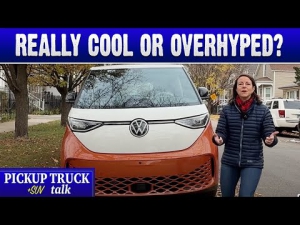4 Reasons Electric 4x4s Will Be Better Off-Road
You have heard us say electric pickup trucks really are the next big thing. The electric vehicle (EV) will soon revolutionize the commute, the job site, and even the outdoors. The next generation of electric 4x4s will be beasts capable of conquering off-road trails that internal combustion engine (ICE) owners avoid, with bulletproof drivetrains and technology enabling their drivers to overland indefinitely.
1. The Rivian R1T is More Capable Than ICEs Off-Road
Vehicles of any kind face two main challenges off-road: producing high torque at low speed and distributing that power to the tire/s that has the most traction. Many ICEs must rev above 4,000 RPMs to reach their full torque potential; ICE vehicles need crawler-speed first gears or low range differentials to off-road. Electric engines, however, can leverage all available torque while creeping along at one RPM: EVs are naturally much more capable of navigating off-road terrain.
In pursuit of better traction, automakers developed four-wheel-drive, all-wheel-drive, and finally adaptive all-wheel-drive systems; off-roading enthusiasts further modify their drivetrains with limited-slip or fully locking differentials. These developments ensure that at least some of the single engine’s rotational power arrives at the wheel with the most traction. But these systems require heavy components which wear out quickly.

The next generation of 4x4s will have multiple engines and automatically modulate power by controlling the electricity supplied to each motor. Land Rover’s chief product engineer, Stuart Frith, told EV Central that he likes “electric power for off-road vehicles…It’s very easy to modulate, easy to control.” The all-electric Porsche Taycan 4S demonstrates the future of power modulation: its traction control system adapts ten times faster than the marque’s flagship ICE sports cars.
The Rivian R1T personifies the off-road capabilities enabled by an all-electric drivetrain. Rivian’s four-engine chassis eats up the most challenging terrain by directing all power to the tire/s with the most traction. Future updates will only make this software-controlled system more effective.
Finally, the heaviest component of an EV is its battery pack; the ubiquitous “skateboard” chassis layout packages an EV’s batteries between the vehicle’s frame rails, lowering its center of gravity, and making it more stable than a comparable ICE.
2. The Lordstown Endurance Boasts Unprecedented Reliability

Electric 4x4s will be more durable than their ICE counterparts because they have less components to break. The first EV startup banking on reliability was the Lordstown Endurance pickup, targeting the fleet vehicle market. Lordstown engineered a truck with fewer moving parts than any motor vehicle on the road by employing in-wheel hub motors to avoid half-shafts and a solid rear axle to avoid unnecessary suspension components.
Off-road, EVs will not only become more reliable than their ICE counterparts but will feature backup components—such as engines—making it easier to get home after a malfunction. The underside of an ICE vehicle is a vulnerable tangle of critical components: bottoming out can spell certain doom. An EV 4×4 with a properly encased battery pack is indestructible by comparison. And when fording a river, an ICE vehicle will always be limited by its air intake, but a well-waterproofed EV has no such weakness.
3. The Tesla Cybertruck Will Offer Endless Overlanding Range

Overlanders in ICE vehicles must return to civilization to fuel up. But you can set up an EV charging station anywhere there is a power line. With the launch of its 4xe, Jeep installed charging stations at trailheads around the country. In addition, Rivian is establishing charging stations at many wilderness destinations as part of The Rivian Adventure Network. In the future, solar-powered charging stations could be deployed far beyond the trailhead—even dropped by helicopter on popular trails or in the middle of the wilderness.
Recently, Elon Musk tweeted that the Cybertruck will have “an option to add solar power that generates 15 miles per day, possibly more.” Fifteen miles a day may not cover the commute for most Americans, but it would allow a recreational overlander exploring the wilderness an endless, leisurely vacation.
4. Electric 4x4s Will Inspire a New Generation of Off-Roading Enthusiasts

EVs will make motorsports appealing to a new generation: Automakers such as Fisker are showcasing off-road technology in the upcoming Extreme E EV-only off-road racing championship.
Low-impact EVs appeal to environmentally conscious motorists. Those who choose 4×4 EVs can explore the wilderness in a capable, reliable vehicle. This generator on wheels will enable them to camp with luxury, plugging in electric cooktops and lights. A new generation of devotees will discover off-roading—aboard a 4×4 EV.
RELATED: Are There Any 4WD Electric Cars on the Market?
The post 4 Reasons Electric 4x4s Will Be Better Off-Road appeared first on MotorBiscuit.







